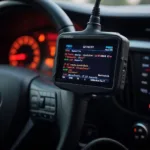OBD2, or On-Board Diagnostics II, is a standardized system that allows external electronics to interface with a vehicle’s computer system for diagnostics and troubleshooting. Knowing the OBD2 requirement year for your vehicle is crucial for choosing the right scanner and understanding its capabilities. But when did this system become mandatory, and how does it impact your car? This article delves into the history of OBD2, explaining the implementation timeline and variations across different regions and vehicle types.
The OBD2 standard wasn’t adopted overnight. Its implementation rolled out over several years, starting in 1996 for all new cars and light trucks sold in the United States. This standardization was a significant step in vehicle emissions control and diagnostics. However, the story is more nuanced than a single date. Understanding the specifics of the OBD2 requirement year will help you select the right diagnostic tools and interpret the data they provide. For example, some pre-1996 vehicles may have partial OBD2 compatibility, while others might require entirely different diagnostic approaches. Knowing these distinctions can save you time and frustration.
A Deeper Dive into OBD2 Requirement Year
While 1996 marks the pivotal year for OBD2 implementation in the US, other regions adopted the standard at different times. The European Union, for instance, followed suit with the European On-Board Diagnostics (EOBD) standard, closely aligned with OBD2, phased in starting in 2001 for gasoline vehicles and 2004 for diesel vehicles. These variations are essential to consider, especially when dealing with imported cars. Furthermore, the specific protocols used within the OBD2 framework also evolved over time.
Are you looking for the best OBD2 scanner for your older Saab? Check out the 10 best obd2 scanners for saab 9-5.
What About Vehicles Older Than the OBD2 Requirement Year?
Cars manufactured before the official OBD2 requirement year often utilized earlier onboard diagnostic systems, known as OBD-I. These systems were less standardized and varied significantly between manufacturers. Diagnosing issues in these older vehicles often requires specialized equipment and knowledge specific to the make and model. While some adapters can bridge the gap between OBD-I and OBD-II scanners, they might not offer full functionality. Understanding these differences is crucial for accurate diagnostics.
Why is Knowing the OBD2 Requirement Year Important?
The OBD2 requirement year dictates the diagnostic capabilities available for your vehicle. Post-OBD2 vehicles provide a wealth of data through the standardized connector, enabling comprehensive diagnostics and troubleshooting. This data can range from simple engine codes to detailed sensor readings, allowing mechanics and car owners to pinpoint issues quickly and efficiently. If you’re looking for a reliable OBD2 scanner, you should know what to look for. Maybe is fixd obd2 good can help.
Deciphering OBD2 Protocols and Your Car
Understanding the OBD2 requirement year is just the first step. Different protocols operate within the OBD2 framework, such as ISO9141-2, KWP2000, and CAN bus. These protocols determine how the scanner communicates with your vehicle’s computer. Knowing the specific protocol used in your car ensures compatibility with your chosen OBD2 scanner.
“Knowing the communication protocols is essential for choosing the right scanner,” says automotive diagnostics expert, Dr. Emily Carter. “Mismatched protocols can lead to inaccurate readings or communication failures, hindering your diagnostic efforts.”
OBD2 and Emissions Testing
A key driver behind the OBD2 mandate was emissions control. By standardizing diagnostics, regulatory bodies could ensure that vehicles maintained their emissions performance throughout their lifespan. OBD2 systems monitor various emissions-related components, flagging issues that could lead to increased pollution. This standardization has played a crucial role in improving air quality.
Beyond the Basics: Advanced OBD2 Applications
While primarily used for diagnostics and emissions testing, OBD2 technology extends to various other applications, including performance tuning, data logging, and real-time vehicle monitoring. Understanding the full potential of OBD2 unlocks valuable insights into your vehicle’s operation. Want to connect an aftermarket Bluetooth device? Read about whats the best obd2 scanner connect aftermarket bluetooth.
“Modern OBD2 scanners empower car owners with data-driven insights,” adds automotive engineer, Michael Rodriguez. “From tracking fuel economy to monitoring engine performance, OBD2 has become an invaluable tool for anyone interested in understanding their vehicle better.” Interested in updating your Innova 3100? Find out how with innova obd2 3100 update.
In conclusion, understanding the OBD2 requirement year is essential for effectively utilizing diagnostic tools and comprehending your vehicle’s systems. From its initial implementation in 1996 to its global adoption and evolving protocols, OBD2 has revolutionized vehicle diagnostics and emissions control. This knowledge equips you to make informed decisions about scanner selection, troubleshooting, and exploring the broader applications of this powerful technology.
FAQ
- What does OBD2 stand for? On-Board Diagnostics II.
- When was OBD2 required? 1996 for all new cars and light trucks sold in the US.
- Does my car have OBD2? Most cars made after 1996 in the US have OBD2.
- What are OBD2 protocols? These are communication standards used by the OBD2 system.
- Why is OBD2 important? It helps with diagnostics, emissions control, and other applications.
- How can I tell if my car is pre-OBD2? Check your owner’s manual or look for a 16-pin connector under the dashboard.
- What if my car is older than the OBD2 requirement year? You may need specialized diagnostic equipment.
Need support? Contact us via WhatsApp: +1(641)206-8880, Email: [email protected] or visit us at 789 Elm Street, San Francisco, CA 94102, USA. Our customer service team is available 24/7.


